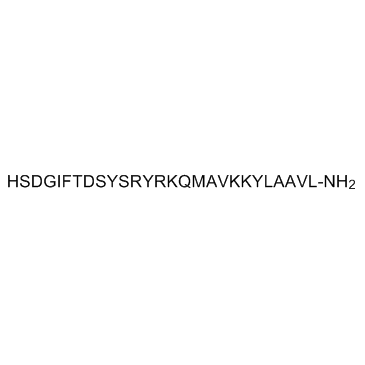127317-03-7
| Name | L-Histidyl-L-seryl-L-α-aspartylglycyl-L-isoleucyl-L-phenylalanyl-L-threonyl-L-α-aspartyl-L-seryl-L-tyrosyl-L-seryl-L-arginyl-L-tyrosyl-L-arginyl-L-lysyl-L-glutaminyl-L-methionyl-L-alanyl-L-valyl-L-lysyl-L-lysyl-L-tyrosyl-L-leucyl-L-alanyl-L-alanyl-L-valyl-L-leucinamide |
|---|---|
| Synonyms |
MFCD00167418
L-Leucinamide, L-histidyl-L-seryl-L-α-aspartylglycyl-L-isoleucyl-L-phenylalanyl-L-threonyl-L-α-aspartyl-L-seryl-L-tyrosyl-L-seryl-L-arginyl-L-tyrosyl-L-arginyl-L-lysyl-L-glutaminyl-L-methionyl -L-alanyl-L-valyl-L-lysyl-L-lysyl-L-tyrosyl-L-leucyl-L-alanyl-L-alanyl-L-valyl- ADENYLATE CYCLASE ACTIVATING PEPTIDE-27 L-Histidyl-L-seryl-L-α-aspartylglycyl-L-isoleucyl-L-phenylalanyl-L-threonyl-L-α-aspartyl-L-seryl-L-tyrosyl-L-seryl-L-arginyl-L-tyrosyl-L-arginyl-L-lysyl-L-glutaminyl-L-methionyl-L-alanyl-L-val yl-L-lysyl-L-lysyl-L-tyrosyl-L-leucyl-L-alanyl-L-alanyl-L-valyl-L-leucinamide Talopram hydrochloride PACAP (1-27), human, ovine, rat |
| Description | PACAP (1-27), human, ovine, rat, the N-terminal fragment of PACAP-38, is a potent PACAP receptor antagonist with IC50s of 3, 2, and 5 nM, respectively, for rat PAC1, rat VPAC1, and human VPAC2. |
|---|---|
| Related Catalog | |
| Target |
IC50: 3 nM (rat PAC1), 2 nM (rat VPAC1), 5 nM (human VPAC2)[1] |
| In Vitro | The PACAP type I and II receptors recognize PACAP-27 and PACAP-38 with an equal high affinity[1]. PACAP(1-27) exhibits a distinct and much higher susceptibility to VIP-amino acid substitutions, compared to PACAP (1-38). Positions 4 and 5 seem to be most important for receptor binding of PACAP (1-27), whereas position 13 is identified to be crucial for maximal affinity of PACAP (1-38)[2]. |
| In Vivo | PACAP (1-27) produces significant bronchodilatation and rapid onset of sustained action and without pronounced cardiovascular side effects. This peptide may have therapeutic potential as a bronchodilator[3]. PACAP(1-27) (0.005-5 μg) increases the basal insulin secretion by about 15 folds in a dose-dependent manner. Local infusion of either glucose (5%) or PACAP(1-27) (0.05 μg) results in a significant increase in the basal insulin output to about 300 μUx per min per g. PACAP(1-27) directly enhances the glucose-evoked insulin secretion in the endocrine pancreas in anesthetized dogs. The study suggests that PACAP may play a local facilitating role in insulin secretion in response to glucose loading[4]. |
| Animal Admin | Guinea-pigs[3] PACAP-27 (0.045 to 4.5 nmol/kg/min), salbutamol (0.045 to 4.5 nmol/kg/min) or sterile saline is given i.v. (1.0 mL) via an infusion pump, starting 5 min before and continuing 10 min after airway challenge[3]. Dogs[4] Four dogs (28.4±1.8 kg) receive PACAP (1-27) with four different concentrations of 0.01, 0.1, 1.0 and 10 µg/mL, or 0.00318, 0.0318, 0.318 and 3.18 µM, respectively. Each solution is locally infused at a rate of 0.5 mL/min for precisely 1 min. A total dose delivered to the pancreas during each infusion is therefore 0.005, 0.05, 0.5 and 5 µg. The dead volume of the pancreatic arterial catheter (0.5 mL) is taken into account in relation to the infusion rate. After taking the initial control sample, simultaneously from the SPD vein and the aorta, saline is infused for 1 min and samples are obtained 1, 3 and 5 min after the onset of infusion. This procedure is repeated every 15 min for the doses of PACAP (1-27). The sample obtained at 15 min after the onset of each infusion served as control for the subsequent intervention[4]. |
| References |
| Density | 1.5±0.1 g/cm3 |
|---|---|
| Molecular Formula | C142H224N40O39S |
| Molecular Weight | 3147.608 |
| Exact Mass | 3145.649414 |
| PSA | 1340.85000 |
| LogP | -3.65 |
| Appearance | solid | white |
| Index of Refraction | 1.657 |
| Storage condition | −20°C |
| Personal Protective Equipment | Eyeshields;Gloves;type N95 (US);type P1 (EN143) respirator filter |
|---|---|
| RIDADR | NONH for all modes of transport |
| WGK Germany | 3 |

